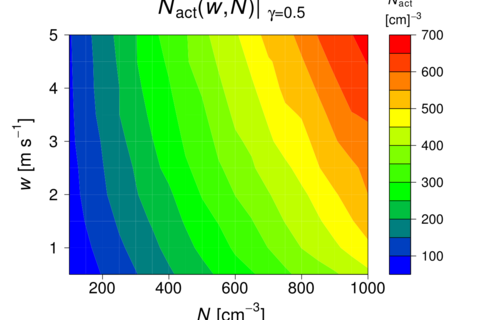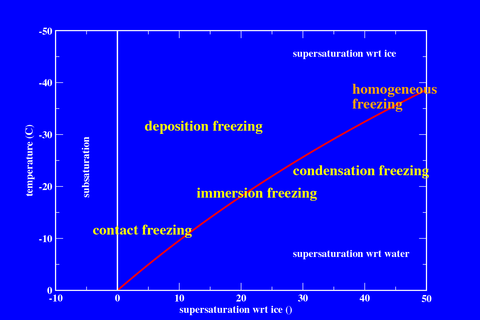Modelling of aerosol cloud interaction
From the cloud microphysical point of view, the interaction of particles and clouds can be divided into two main topics:
1. Influence of aerosol on cloud droplet activation
Under atmospheric conditions, cloud droplets form when air becomes (super-) saturated with respect to water. However, the excess water is not forming pure water drops but is deposited on so-called CCN (Cloud Condensation Nuclei). Whether a particle serves as a CCN in a certain situation depends on the particle properties (mainly size and chemical composition) as well as on atmospheric dynamics (mainly updraft velocity). Almost all air-borne particles above a certain size (50-80 nm) are potential CCN.
- Generally, drop numbers become larger when
- CCN number increases
- Particles become larger
- Particles are water-soluble
- Updraft velocity increases
Changes in cloud droplet formation influence cloud properties such as radiation properties and precipitation formation by coalescence. With the microphysical model SPECS we study in which way a cloud (in terms of drop number, water mixing ratio, precipitation, etc.) reacts on changes in the aerosol population and which of the above mentioned parameters are the dominating ones in a specific situation. E.g., for low CCN concentrations, drop numbers do almost not increase with increasing updraft (above a certain threshold) whereas for higher CCN numbers droplet activation typically is very sensitive to changes in updraft velocity.
2. Influence on (primary) ice formation
In the atmosphere, supercooled drops are observed down to -40 °C, where homogeneous freezing occurs. For freezing at warmer temperatures, particles acting as so-called IN (Ice Nuclei) are necessary. Compared to the CCN, the IN are a rather small subset of the atmospheric particles. Typically, IN are at least partly insoluble particles and can be divided into
- Biological particles (bacteria, pollen, funghi spores, ...)
- Mineral dust particles
- Soot particles
Those IN are active at very different temperatures and freezing modes. They influence ice formation and, therefore, e.g. precipitation as well as cloud dynamics (via latent heat release).
At TROPOS models are used to compare, for CCN and IN, the importance of aerosol influence on cloud microphysics to other driving forces such as the underlying general dynamics, turbulence, or other parameters.
- Small scale process modelling (FLUENT-FPM und Soccer ball model)


